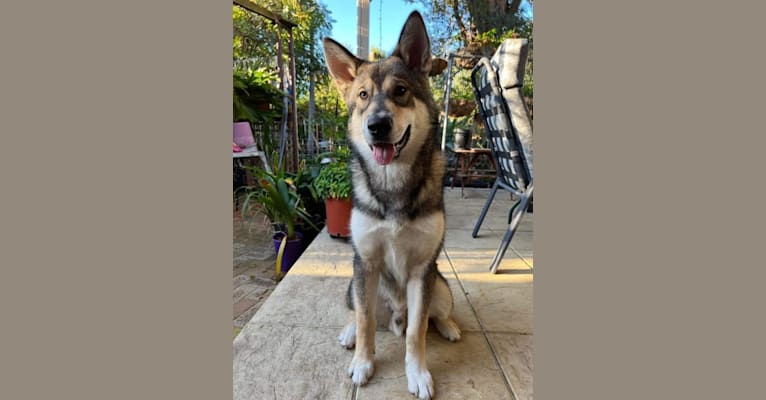Loki inherited one copy of the variant we tested
No Dogs Available
It looks like you don’t have any dogs on your account yet. Activate a kit now!
No bio has been provided yet
Place of Birth
Perth WA, Australia
Current Location
Perth, Western Australia, Australia
From
Perth WA, Australia
This dog has been viewed and been given 3 wags
Start a conversation! Message this dog’s owner.
Explore
Health Summary
Loki has one variant that you should let your vet know about.
ALT Activity
Why is this important to your vet?
Loki has one copy of a variant associated with reduced ALT activity as measured on veterinary blood chemistry panels. Please inform your veterinarian that Loki has this genotype, as ALT is often used as an indicator of liver health and Loki is likely to have a lower than average resting ALT activity. As such, an increase in Loki’s ALT activity could be evidence of liver damage, even if it is within normal limits by standard ALT reference ranges.
What is ALT Activity?
Alanine aminotransferase (ALT) is a clinical tool that can be used by veterinarians to better monitor liver health. This result is not associated with liver disease. ALT is one of several values veterinarians measure on routine blood work to evaluate the liver. It is a naturally occurring enzyme located in liver cells that helps break down protein. When the liver is damaged or inflamed, ALT is released into the bloodstream.
Breed-Relevant Genetic Conditions
Multiple Drug Sensitivity (ABCB1)
Identified in Czechoslovakian Vlcaks and German Shepherd Dogs
Variant not detected
Factor VII Deficiency (F7 Exon 5)
Identified in Alaskan Malamutes
Variant not detected
Hemophilia A (F8 Exon 11, German Shepherd Variant 1)
Identified in Czechoslovakian Vlcaks and German Shepherd Dogs
Variant not detected
Hemophilia A (F8 Exon 1, German Shepherd Variant 2)
Identified in Czechoslovakian Vlcaks and German Shepherd Dogs
Variant not detected
Canine Leukocyte Adhesion Deficiency Type III, CLAD III (FERMT3, German Shepherd Variant)
Identified in Czechoslovakian Vlcaks and German Shepherd Dogs
Variant not detected
Platelet Factor X Receptor Deficiency, Scott Syndrome (TMEM16F)
Identified in Czechoslovakian Vlcaks and German Shepherd Dogs
Variant not detected
X-Linked Progressive Retinal Atrophy 1, XL-PRA1 (RPGR)
Identified in Siberian Huskies
Variant not detected
Day Blindness (CNGB3 Deletion, Alaskan Malamute Variant)
Identified in Alaskan Malamutes and Siberian Huskies
Variant not detected
Day Blindness (CNGA3 Exon 7, German Shepherd Variant)
Identified in Czechoslovakian Vlcaks and German Shepherd Dogs
Variant not detected
Urate Kidney & Bladder Stones (SLC2A9)
Identified in Czechoslovakian Vlcaks and German Shepherd Dogs
Variant not detected
Primary Ciliary Dyskinesia, PCD (NME5, Alaskan Malamute Variant)
Identified in Alaskan Malamutes
Variant not detected
Anhidrotic Ectodermal Dysplasia (EDA Intron 8)
Identified in Czechoslovakian Vlcaks and German Shepherd Dogs
Variant not detected
Renal Cystadenocarcinoma and Nodular Dermatofibrosis (FLCN Exon 7)
Identified in Czechoslovakian Vlcaks and German Shepherd Dogs
Variant not detected
Mucopolysaccharidosis Type VII, Sly Syndrome, MPS VII (GUSB Exon 3, German Shepherd Variant)
Identified in Czechoslovakian Vlcaks and German Shepherd Dogs
Variant not detected
GM1 Gangliosidosis (GLB1 Exon 15, Alaskan Husky Variant)
Identified in Siberian Huskies
Variant not detected
Degenerative Myelopathy, DM (SOD1A)
Identified in Czechoslovakian Vlcaks, German Shepherd Dogs, and more
Variant not detected
Alaskan Malamute Polyneuropathy, AMPN (NDRG1 SNP)
Identified in Alaskan Malamutes
Variant not detected
Additional Genetic Conditions
Explore
What is a linkage test?
DNA sequences that are close together on a chromosome tend to be inherited together. Because of this, we can use genetic variation surrounding a specific variant (i.e. "linked" to it) to infer the presence or absence of a variant that is associated with a health condition or trait.
Linkage tests are not as predictive of your dog’s true genotype as direct assays, which we use on most other genetic conditions we test for.
Traits
Explore the genetics behind your dog’s appearance and size.
No Result
For every test, we run multiple assays to ensure the accuracy of the results we deliver. For your dog, one or more of these produced inconclusive or low confident results. Therefore, we are not able to provide you with a result at this time.
Coat Color
No Result
For every test, we run multiple assays to ensure the accuracy of the results we deliver. For your dog, one or more of these produced inconclusive or low confident results. Therefore, we are not able to provide you with a result at this time.
Other Coat Traits
No Result
For every test, we run multiple assays to ensure the accuracy of the results we deliver. For your dog, one or more of these produced inconclusive or low confident results. Therefore, we are not able to provide you with a result at this time.
Other Body Features
No Result
For every test, we run multiple assays to ensure the accuracy of the results we deliver. For your dog, one or more of these produced inconclusive or low confident results. Therefore, we are not able to provide you with a result at this time.
Body Size
No Result
For every test, we run multiple assays to ensure the accuracy of the results we deliver. For your dog, one or more of these produced inconclusive or low confident results. Therefore, we are not able to provide you with a result at this time.














